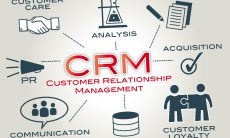Every job seeker knows that his network is the key to his next employment opportunity. In theory, every digital media marketer is or has been a job seeker at some point. So why does it seem that we only think about the network in terms of personal use? How can we use our organization’s extended network as part of our marketing efforts?

For some reason, perhaps because we’re sitting in front of a computer (or, increasingly, navigating the surface of one in our hand), we tend to more closely associate the word “network” with this definition of the word (from Merriam-Webster’s):
a system of computers, peripherals, terminals, and databases connected by communications lines
1. The Extended Network
What we forget is that despite the distance and arguably impersonal nature of talking to people via the tiny computer in our hand, the correct definition of “network” (for purposes of marketing, that is) is this (also from M-W):
an informally interconnected group or association of persons (as friends or professional colleagues)
All of your employees have networks and many of them actively engage in social networks – Facebook, Twitter, Pinterest, and LinkedIn. Collectively, that’s a lot of ready-made connections for your company. In particular, LinkedIn – the “professional” social network – offers an unprecedented opportunity for businesses to find and nurture new clients.
How can you work LinkedIn to convert a customer service rep’s brother-in-law into a customer? Or an executive’s professional organization connection into a new partner?
2. Business is Personal
Many mid-sized and big businesses still spend the majority of their marketing budgets on traditional tactics. And that’s fine, to a point. But buyer expectations have changed substantially, and it’s not just online.
People want to do business with people. They’re frustrated by automated customer service lines. They don’t like Contact Us Web forms. They hate the faceless monster. They want salespeople to call them back promptly, and they want them to stay in touch – but not in an obnoxious, stalking kind of way.
Leveraging your organization’s extended network – those existing relationships that employees have built with their friends, family and business colleagues – can help you shorten the sales cycle.
3. Relationships Take Time
The problem is that despite the rapid adoption of LinkedIn – it’s said to be adding two new users per second – many employees still haven’t built out their networks on the service. Because of this propensity to think of LinkedIn as primarily a job-hunting tool, many employees ignore it until, well, they actually need it.
The time to start leveraging your social or professional network is a week ago, a month ago, a year ago. We seem to forget that networking is a relationship-building process that takes time. Both networks and relationships require constant nurturing. An oft-used analogy is the garden: you need to sow the seeds, cultivate the ground, and provide constant attention before you can harvest the bounty.
This process is the same whether you are looking for a new job or a new client.
4. Referrals Mean Business
So what does nurturing look like for digital media marketers?
A year ago, I started my own consulting business and from the start, I’ve had a steady stream of clients. To a major brand, my marketing strategy might seem laughable. I have the obligatory Web site, but I don’t advertise or send email newsletters.
The core of my strategy is networking, both online and off. I’ve got a robust LinkedIn presence, and I’m active on Facebook, Twitter, Pinterest, and Foursquare. I comment – a lot – on what people are doing. I share my activities.
But not just online. I also drink a lot of coffee, take a lot of lunches, volunteer on boards, and attend many events. I talk a lot, and I listen a lot. The result? All of my clients – except one – are referrals.
5. Turn Employees Into Brand Ambassadors
- Training. It may seem counterintuitive to train your employees to use LinkedIn – or to incent them to build their network – especially when LinkedIn is the #1 online recruiting tool. But its potential for building brand credibility and bringing in new business is huge. Employees should be taught how to search the database for potential buyers, how to use their connections to meet those buyers, and how to engage in group discussions to raise their own and, by extension, the company’s profile. They should be briefed on the best way to present themselves and the organization.
- Great content. Provide employees with high-value content to share with their networks, and ensure that you provide them with a few minutes each week to cultivate relationships on LinkedIn. Content should be a mix of original (white papers, ebooks, infographics, blog posts) along with curated. You can set up a Twitter feed to easily share the content widely within the organization (note that Twitter has discontinued its sharing link to LinkedIn, so your employees will need to cut and paste, or use a tool like Hootsuite).
- Events. Get personal by hosting live in-person events, whether it’s a cozy wine tasting at your offices or a networking event at a large industry conference, make an effort to get face-to-face.
- Offers. Provide online opportunities to learn and chat. Offer free webinars, trials or discounts on new products.
The sooner you begin viewing LinkedIn as a new business tool, the more ways you’ll find to engage your organization’s extended network and the more you’ll discover that it is indeed a digital media marketer’s most powerful asset.






